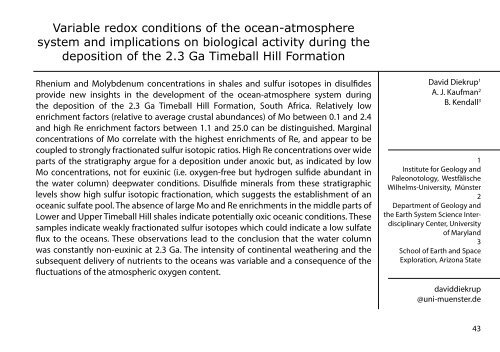2nd annual MGSE Symposium - Institute for Evolution and ...
2nd annual MGSE Symposium - Institute for Evolution and ...
2nd annual MGSE Symposium - Institute for Evolution and ...
You also want an ePaper? Increase the reach of your titles
YUMPU automatically turns print PDFs into web optimized ePapers that Google loves.
Variable redox conditions of the ocean-atmosphere<br />
system <strong>and</strong> implications on biological activity during the<br />
deposition of the 2.3 Ga Timeball Hill Formation<br />
Rhenium <strong>and</strong> Molybdenum concentrations in shales <strong>and</strong> sulfur isotopes in disulfides<br />
provide new insights in the development of the ocean-atmosphere system during<br />
the deposition of the 2.3 Ga Timeball Hill Formation, South Africa. Relatively low<br />
enrichment factors (relative to average crustal abundances) of Mo between 0.1 <strong>and</strong> 2.4<br />
<strong>and</strong> high Re enrichment factors between 1.1 <strong>and</strong> 25.0 can be distinguished. Marginal<br />
concentrations of Mo correlate with the highest enrichments of Re, <strong>and</strong> appear to be<br />
coupled to strongly fractionated sulfur isotopic ratios. High Re concentrations over wide<br />
parts of the stratigraphy argue <strong>for</strong> a deposition under anoxic but, as indicated by low<br />
Mo concentrations, not <strong>for</strong> euxinic (i.e. oxygen-free but hydrogen sulfide abundant in<br />
the water column) deepwater conditions. Disulfide minerals from these stratigraphic<br />
levels show high sulfur isotopic fractionation, which suggests the establishment of an<br />
oceanic sulfate pool. The absence of large Mo <strong>and</strong> Re enrichments in the middle parts of<br />
Lower <strong>and</strong> Upper Timeball Hill shales indicate potentially oxic oceanic conditions. These<br />
samples indicate weakly fractionated sulfur isotopes which could indicate a low sulfate<br />
flux to the oceans. These observations lead to the conclusion that the water column<br />
was constantly non-euxinic at 2.3 Ga. The intensity of continental weathering <strong>and</strong> the<br />
subsequent delivery of nutrients to the oceans was variable <strong>and</strong> a consequence of the<br />
fluctuations of the atmospheric oxygen content.<br />
David Diekrup 1<br />
A. J. Kaufman 2<br />
B. Kendall 3<br />
1<br />
<strong>Institute</strong> <strong>for</strong> Geology <strong>and</strong><br />
Paleonotology, Westfälische<br />
Wilhelms-University, Münster<br />
2<br />
Department of Geology <strong>and</strong><br />
the Earth System Science Interdisciplinary<br />
Center, University<br />
of Maryl<strong>and</strong><br />
3<br />
School of Earth <strong>and</strong> Space<br />
Exploration, Arizona State<br />
daviddiekrup<br />
@uni-muenster.de<br />
43



